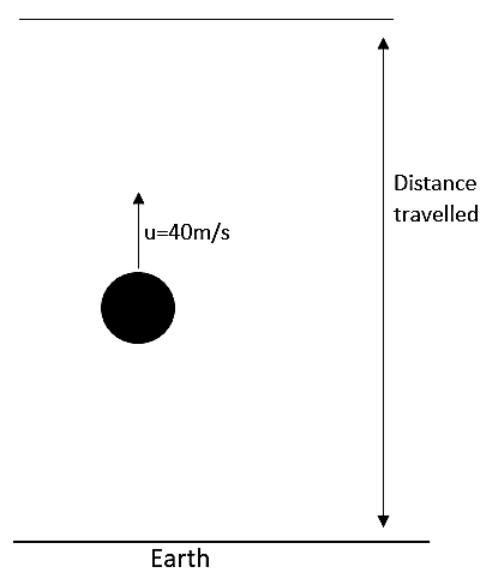
A stone is thrown upwards vertically, with an initial velocity given as $40m{{s}^{-1}}$. Taking $g=10m{{s}^{-2}}$, the total displacement and the total distance traversed by the stone when it reaches the ground will be
$\begin{align}
& A.\text{displacement}=0,\text{distance}=80m \\
& B.\text{displacement}=0,\text{distance}=160m \\
& C.\text{displacement}=80m,\text{distance}=160m \\
& D.\text{displacement and distance}=180m \\
\end{align}$
Answer
574.2k+ views
Hint: In this question, Newton’s third equation of motion has been used to find the distance travelled by the stone in one direction. After that using this the total distance covered can be found out by taking the sum of distance covered in upward and downward directions. The displacement is the resultant distance covered by a body. These all may help you to solve this question.
Complete answer:
First of all let us take a look at what all are given in the question. It has been given that the initial velocity with which the stone is thrown upwards can be written as,
$u=40m{{s}^{-1}}$
The final velocity of the stone when it reaches the ground will be,
$v=0m{{s}^{-1}}$
The height or the distance up to which the stone will go can be expressed as $s$.

We all know that the newton’s third equation of motion can be written as,
${{v}^{2}}={{u}^{2}}+2gs$
Where $g$ be the acceleration due to gravity.
$g=10m{{s}^{-2}}$
Rearranging this equation will give,
$s=\dfrac{{{v}^{2}}-{{u}^{2}}}{2g}$
Substituting the values in the equation,
$s=\dfrac{{{0}^{2}}-{{40}^{2}}}{2\times -10}$
The negative sign is because of the motion in the direction opposite to that of acceleration due to gravity.
The equation can be simplified as,
$s=\dfrac{-1600}{-20}$
Therefore the distance travelled in the upward direction is,
$s=80m$
The total distance of travel is to be calculated here.
That is, the total distance travelled is the sum of distance travelled upwards and same in downwards.
Both the distance will be same therefore the total distance travelled will be,
$S=160m$
The displacement of the body is found using the initial and final points only. As they are both the same, the displacement will be zero.
$d=0m$
Therefore the correct answer is option B.
Note:
Displacement is defined as the change in the position of an object. Displacement is direction dependent, so that it is a vector quantity. It does not depend on the path taken to travel. Only depends on the initial and final position of the body.
Complete answer:
First of all let us take a look at what all are given in the question. It has been given that the initial velocity with which the stone is thrown upwards can be written as,
$u=40m{{s}^{-1}}$
The final velocity of the stone when it reaches the ground will be,
$v=0m{{s}^{-1}}$
The height or the distance up to which the stone will go can be expressed as $s$.

We all know that the newton’s third equation of motion can be written as,
${{v}^{2}}={{u}^{2}}+2gs$
Where $g$ be the acceleration due to gravity.
$g=10m{{s}^{-2}}$
Rearranging this equation will give,
$s=\dfrac{{{v}^{2}}-{{u}^{2}}}{2g}$
Substituting the values in the equation,
$s=\dfrac{{{0}^{2}}-{{40}^{2}}}{2\times -10}$
The negative sign is because of the motion in the direction opposite to that of acceleration due to gravity.
The equation can be simplified as,
$s=\dfrac{-1600}{-20}$
Therefore the distance travelled in the upward direction is,
$s=80m$
The total distance of travel is to be calculated here.
That is, the total distance travelled is the sum of distance travelled upwards and same in downwards.
Both the distance will be same therefore the total distance travelled will be,
$S=160m$
The displacement of the body is found using the initial and final points only. As they are both the same, the displacement will be zero.
$d=0m$
Therefore the correct answer is option B.
Note:
Displacement is defined as the change in the position of an object. Displacement is direction dependent, so that it is a vector quantity. It does not depend on the path taken to travel. Only depends on the initial and final position of the body.
Recently Updated Pages
Why are manures considered better than fertilizers class 11 biology CBSE

Find the coordinates of the midpoint of the line segment class 11 maths CBSE

Distinguish between static friction limiting friction class 11 physics CBSE

The Chairman of the constituent Assembly was A Jawaharlal class 11 social science CBSE

The first National Commission on Labour NCL submitted class 11 social science CBSE

Number of all subshell of n + l 7 is A 4 B 5 C 6 D class 11 chemistry CBSE

Trending doubts
What is meant by exothermic and endothermic reactions class 11 chemistry CBSE

10 examples of friction in our daily life

One Metric ton is equal to kg A 10000 B 1000 C 100 class 11 physics CBSE

1 Quintal is equal to a 110 kg b 10 kg c 100kg d 1000 class 11 physics CBSE

Difference Between Prokaryotic Cells and Eukaryotic Cells

What are Quantum numbers Explain the quantum number class 11 chemistry CBSE




